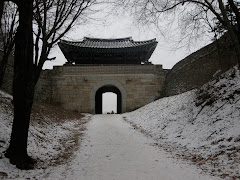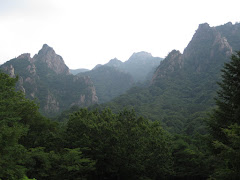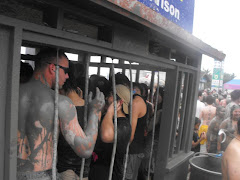My 11 day winter vacation resumed exactly 9 hours following the conclusion of The Korean Road Trip. 11 days away from school was spectacular, though, it proved to be to be somewhat tiring, and, of course, too short..
Papa Sparrow arrived at Incheon International Airport on Monday, December 28th at 9pm. His flight was without incident, or so he says, and it took 13 hours to fly from Detroit to Tokyo, and another 2 hours to fly from Tokyo to Incheon. He was tired from the flight, though he recovered well and was a new man early Tuesday. Well, sort of...
The weather in Seoul was brutally cold this week, and so our activities were limited. Tuesday (Day 1) was spent touring the sights of Seoul. Namsan, Seoul Tower, Gwanghamun, Namdaemun, and Insadong were all part of the day's events. These are some of Seoul's best tourist features, in my opinion. Should the weather have been better, and we had more time, I would have also included such places as Seonyudo, the National Museum of Korea, 63 Building, Gyeongbokgong, and a Han River cruise. Korean street food such as pajung and odang were introduced in the Korean markets, and lunch at one of Seoul's best sushi restaurants, Sushi Hyo, was also included. Yum!
We visited the lonesome town of Sanbon on Wednesday (Day 2), and later a trip to Paju, one of the Northwestern-most cities, located near the DMZ. Similar to last week's experience near the Eastern shores, the DMZ is a sobering experience, heightened especially by the bitter cold temperatures in the air that day. Apparently, while snapping photos of the area, I was scolded by a South Korean soldier and asked (told) not to photograph certain things. I say apparently, because I did not originally hear this and so I continued snapping photos without care. Thankfully, no incident prevailed.
There are numerous DMZ tours offered, and tour buses depart frequently from Incheon Airport and various locations throughout Seoul. In order to actually visit the DMZ line and stand feet from North Korean soldiers, you must be a part of one of these organized tours, which is probably a good idea so tourists from Ohio do not accidentally step across the line and cause an international incident. Unfortunately, these tours also require half the day and are costly; usually 70,000 Won per person or more. Thus, we did not partake in a tour, and instead, opted to visit the Reunification Museum and look out at North Korean soil from a distance of about 2 kilometers across the frozen river.
Dinner Tuesday night was at a famous traditional Korean restaurant named SamcheongGak. (About SamcheongGak) It's located atop Bukak Mountain overlooking Seoul and is a magnificent setting. It has a rich history, mostly due to it's location near the presidential residence and government offices, so many important historical events have occurred here. The decor inside the restaurant is beautiful and dinner was exotic. A variety of traditional Korean foods were served, which were most unique and served as one of the best dining experiences.
Thursday (Day 3) began early morning as we boarded a KTX train for Mokpo, Korea's Southwestern-most city. The 3 hour train ride was without incident, and it was especially nice to look at the passing countryside, which was blanketed with fresh snow from the night before. It was beautiful, especially when traveling on the ultra fast, ultra quiet, and ultra comfortable KTX.
Noon arrival in Mokpo meant we had to immediately head to the Mokpo Ferry Terminal to secure our passage to Jeju Island. This was, unfortunately, not a smooth endeavor. After arriving at the ferry terminal, we quickly learned that the ferry ship we had reservations on was cancelled due to bad weather, and we were forced to take another vessel. In other words, the second ship was now sold out, and actually overbooked. Individual ticket prices remained the same at 45,000 Won, but unfortunately, there were no reserved seats and so only floor seating was offered. This would normally be okay for someone like myself, but the senior Mr. Sparrow cannot stand or sit on the floor for five hours. So the back and forth game of elementary communication with the representative began; trying to negotiate some form of seating.
The hero of this story was Gemma, who, via telephone, was somehow able to convince the ferry representative to arrange priority seating for us, in the ship's lounge, which turned out to be fairly decent, and thus diffusing the situation. I have always been fortunate when traveling in Korea and have had the beneficial resource of many students and friends who seem to be there to help whenever I need it most. Honestly speaking, my travels would not be nearly as smooth without their assistance and I am forever grateful.
I must admit, the experience at the Mokpo Ferry Terminal was one of the worst experiences I have had in Korea. I understand that ferry reservations can be cancelled due to weather, but as a foreigner and tourist, it's regrettable that the ferry operator does not have a better system for handling this. Especially for foreigners, who clearly do not speak Korean very well, one would think the boat company would employ an English speaking representative to ease the pain during such situations.
This is a prime example of how the Korean Tourism Organization, which hopes to attract 8.5 million visitors to Korea this year under their "Visit Korea" campaign and help bolster the nation's service industry, can work with business owners who are a crucial part of the tourism industry to make the experience more accommodating for foreign tourists. Imagine if we had arrived later and our reservations would somehow not be honored, we would be left without a place to stay in Mokpo, an empty hotel room on Jeju, which was prepaid, and perhaps, no possibility of returning to Seoul.
It should also be noted that I was told, thankfully so, there was a strong possibility the ferry would not be operating on Sunday, our scheduled day to return to Mokpo. This was especially alarming since the other Mr. Sparrow had a flight to catch early the following day departing Seoul. So, I am left with the belief, and recommendation, that the ferry should be avoided at all costs when traveling to Jeju. Instead, any traveler should take a flight, both of which, operate regularly from Seoul and Busan. This is exactly what we arranged for our return trip to Seoul.
Jeju Island
All the difficulty at the ferry terminal was probably worth it because Juju is fantastic in every way. Jeju do (island) is approximately 1,846 square kilometers and is located 130 kilometers from the Southern coast of Korea. South Korea's tallest mountain, Halla San, stands at 1,950 meters (6,397 feet) above the sea and is it's biggest feature. It's a dormant volcano and so the island is volcanic in it's geological makeup. Koreans sometimes call it "Honeymoon Island" because of its popularity with newlyweds, though many couples now vacation in Hawaii, Philippines, and other destinations.
We arrived in Jeju around 7pm, just in time for a brief hotel check-in, rental car pick-up, and New Years Eve dinner at a nearby ohgyeopsal restaurant. Ohgyeopsal is similar to samgyeopsal, except oh is 5 in Korean, instead of sam (3), so the pork has an extra two layers of deliciousness.
Deanna Ho, an American we met on the ferry ride over from Mokpo, also joined us for dinner and New Years celebration. Our new friend was traveling Korea solo, on a one week vacation from work, and eager to experience the Korean countryside and culture. She and I later visited the Jeju Casino at the Marriott Hotel for some blackjack and New Years toasting.
Strangely, Koreans are banned from gambling and cannot enter casinos. Apparently, the casinos exist only for tourists, so a passport is required to enter. Alcoholic drinks are complimentary, but like any casino, they expect you to throw some money around.
Friday (Day 4), New Years Day, we traveled by car to the Eastern side of the island and visited the Manjanggul Lava Tubes along with other local sights. One of the lava tubes is 7,416 meters in length and 30 meters high at parts. Literally, it's big enough to drive a train through, and according to the Jeju tourist info, it's one of the largest lava tubes of its kind in the world.
We also visited Ilchulbong, a stunning 90 meter (300 foot) high crater with a diameter of about 600 meter or 2,000 feet. It rises above the sea like a giant crown and it's a popular hiking spot for many Koreans. They also say sunrise is best viewed from here, though, regrettably, we didn't experience this. Aside from Halla San, Ilchulbong is one of the most recognizable features of Jeju.
Saturday (Day 5) was spent on the Southern and Western halves of the island. The Southern side, known as Seogwipo, is the most beautiful part of Jeju, in my opinion. In order to get to Seogwipo, we drove the mountain pass through the center of the island, climbing to around 1,100 meters and passing snow covered landscapes. What makes the southern side so beautiful are the many waterfalls and coastal cliffs along the edge of the sea.
And a trip to Jeju is not complete without stopping at the Health and Sex Museum, but ticket prices are expensive (15,000 Won per person) so we did not go inside. Instead, I suggest the gift shop and outdoor gardens, which feature anatomical stone statues. In other words, fun for the whole family.
It probably takes about 4 to 5 hours to circumnavigate the island of Jeju. Touring the island can be affordable by bus or group discount rate, though you are limited to your activities, and like any organized tour, are on a time schedule. Transit buses are available but probably difficult without a native Korean speaker or a firm grasp of the language. Instead, I suggest an economy car rental at 60-70,000 Won per day, including insurance. It gives you the freedom to see what you want, usually more of the island, and on your own time schedule.
The 8am return flight to Seoul on Sunday (Day 6) was far less painful than the ferry experience. Jeju Airlines suggest you arrive and check-in a mere 30 minutes before your flight, and the security screenings are far less comprehensive than other parts of the world. The flight lasted approximately one hour, and we were on the ground at Seoul Gimpo Airport by 9am. Gimpo is the older airport, pre-Incheon, and located closer to Seoul so it is now used for mostly domestic flights.
The temperature difference between Jeju and Seoul is dramatic, probably around 20-30 degrees Fahrenheit, and the bitter cold in Seoul was an unwelcome dose of reality. The end of an 11 day vacation was another unwelcome reality, and a sad goodbye with my father was the official end of the trip. He was my first and only visitor thus far, and I'm so glad he made the trip. It was a great holiday.
Classes resumed early Monday morning, 6:30am, and life in Korea continues. Eight months completed. Four months remaining.
God bless and Happy New Year!
























































































































































